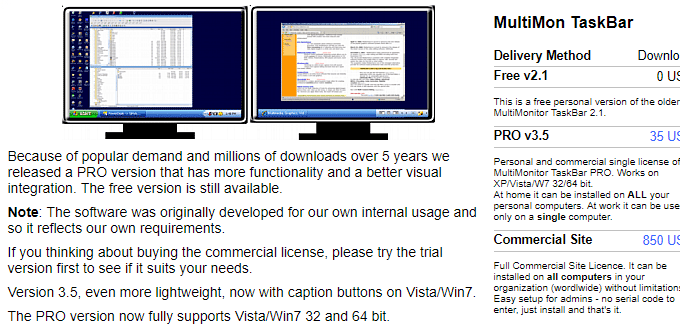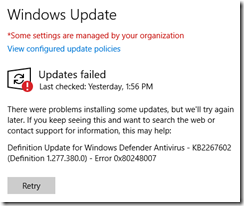

- #Windows 10 transient multimon manager in registry drivers#
- #Windows 10 transient multimon manager in registry update#
- #Windows 10 transient multimon manager in registry manual#
- #Windows 10 transient multimon manager in registry software#

Administrative access with the root account 8.4.2. Integration of inline Python code in templates 8.4. Referencing of UCR variables in templates 8.3.5.2. Policy-based configuration of UCR variables 8.3.5. Using the command line front end 8.3.3.1. Using the Univention Management Console web interface 8.3.3. Collection of list of supported hardware 8.3.Īdministration of local system configuration with Univention Configuration RegistryĨ.3.1. Configuration of the monitor settings 8.2.6.
#Windows 10 transient multimon manager in registry drivers#
Configuration of hardware and drivers 8.2.1. Management of computer accounts in Univention Management Console 8.1.1.

Overlay module for displaying the group information on user objects 8.

Synchronization of Active Directory groups when using Samba 4 7.5. Managing groups in Univention Management Console 7.2. Automatic lockout of users after failed login attempts 6.5.1. Password management via Self Service app 6.5. Password change by user via Univention Management Console 6.4.2. Password settings for Windows clients when using Samba 6.4. User management with Univention Management Console 6.2.
#Windows 10 transient multimon manager in registry software#
Central monitoring of software installation statuses with the software monitor 6.
#Windows 10 transient multimon manager in registry update#
Specification of an update point using the package maintenance policy 5.8. Policy-based installation/uninstallation of individual packages via package lists 5.7. Installation/removal of individual packages in the command line 5.6.4. Installation/removal of individual packages in Univention Management Console 5.6.3. Installation/uninstallation of UCS components in the Univention App Center 5.6.2. Creating and updating a local repository 5.6. Policy-based configuration of the repository server 5.5.4. Configuration via Univention Configuration Registry 5.5.3. Configuration via Univention Management Console 5.5.2. Configuration of the repository server for updates and package installations 5.5.1. Troubleshooting in case of update problems 5.5. Updating individual systems via the command line 5.4.4. Updating individual systems via Univention Management Console 5.4.3. Update strategy in environments with more than one UCS system 5.4.2. Differentiation of update variants / UCS versions 5.3. Adjustment/expansion of Univention Directory Reports 5. Creating reports on the command line 4.11.3. Creating reports in Univention Management Console 4.11.2. Evaluation of data from the LDAP directory with Univention Directory Reports 4.11.1. Example invocations of the command line interface 4.10.2.1. Parameters of the command line interface 4.10.2. Command line interface of domain management (Univention Directory Manager) 4.10.1. Delegated administration in the UMC 4.10. Structuring of the domain with user-defined LDAP structures 4.9. Expansion of UMC with extended attributes 4.8. Operating instructions for modules to administrate LDAP directory data 4.4.3.1. Activation of UCS license / license overview 4.4.3. Converting a backup domain controller backup to the new master domain controller 3.10. Adding a new external service provider 3.9. Reinitialization of listener modules 3.6. Identification of replication problems 3.5.2.3. Log files/debug level of replication 3.5.2.2. Analysis of listener/notifier problems 3.5.2.1. Listener/notifier replication workflow 3.5.2. Listener/notifier domain replication 3.5.1. Configuration of the directory service when using Samba 4 3.4.9. Syncrepl for synchronization with non-UCS OpenLDAP servers 3.4.8. Name Service Switch / LDAP NSS module 3.4.7. Delegation of the privilege to reset user passwords 3.4.6. Access control for the LDAP directory 3.4.5.1. Timeout for inactive LDAP connections 3.4.4. Audit-proof logging of LDAP changes 3.4.3. Domain join using the system preferences GUI 3.2.4.2. Joining domains with Univention Management Console 3.2.1.3. Subsequent domain joins with univention-join 3.2.1.2. Installation in the Amazon EC2 cloud 2.15. Troubleshooting for installation problems 2.13. "Join an existing UCS domain domain" mode 2.9.4. "Join an existing Active Directory domain" mode 2.9.3.
#Windows 10 transient multimon manager in registry manual#
Symbols and conventions used in this manual 2. Expandability with the UniventionĪpp Center 1.2.4. What is Univention Corporate Server? 1.2.


 0 kommentar(er)
0 kommentar(er)
